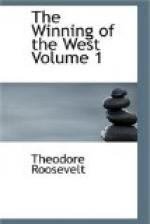The Choctaws, the rudest and historically the least important of these Indians, lived south of the Chickasaws. They were probably rather less numerous than the Creeks.[6] Though accounted brave they were treacherous and thievish, and were not as well armed as the others. They rarely made war or peace as a unit, parties frequently acting in conjunction with some of the rival European powers, or else joining in the plundering inroads made by the other Indians upon the white settlements. Beyond thus furnishing auxiliaries to our other Indian foes, they had little to do with our history.
The Muscogees or Creeks were the strongest of all. Their southern bands, living in Florida, were generally considered as a separate confederacy, under the name of Seminoles. They numbered between twenty-five and thirty thousand souls,[7] three fourths of them being the Muscogees proper, and the remainder Seminoles. They dwelt south of the Cherokees and east of the Choctaws, adjoining the Georgians.
The Creeks and Cherokees were thus by their position the barrier tribes of the South, who had to stand the brunt of our advance, and who acted as a buffer between us and the French and Spaniards of the Gulf and the lower Mississippi. Their fate once decided, that of the Chickasaws and Chocktaws inevitably followed.
The customs and the political and social systems of these two tribes were very similar; and those of their two western neighbors were merely ruder copies thereof. They were very much further advanced than were the Algonquin nations of the north.
Unlike most mountaineers the Cherokees were not held to be very formidable fighters, when compared with their fellows of the lowlands.[8] In 1760 and 1761 they had waged a fierce war with the whites, had ravaged the Carolina borders, had captured British forts, and successfully withstood British armies; but though they had held their own in the field, it had been at the cost of ruinous losses. Since that period they had been engaged in long wars with the Chickasaws and Creeks, and had been worsted by both. Moreover, they had been much harassed by the northern Indians. So they were steadily declining in power and numbers.[9]
Though divided linguistically into two races, speaking different dialects, the Otari and Erati, the political divisions did not follow the lines of language. There were three groups of towns, the Upper, Lower, and Middle; and these groups often acted independently of one another. The Upper towns lay for the most part on the Western Waters, as they were called by the Americans,—the streams running into the Tennessee. Their inhabitants were known as Overhill Cherokees and were chiefly Otari; but the towns were none of them permanent, and sometimes shifted their positions, even changing from one group to another. The Lower towns, inhabited by the Erati, lay in the flat lands of upper Georgia and South Carolina, and were the least important. The third group, larger than either of the others and lying among the hills and mountains between them, consisted of the Middle towns. Its borders were ill-marked and were ever shifting.




